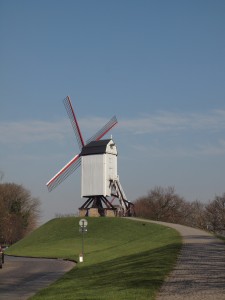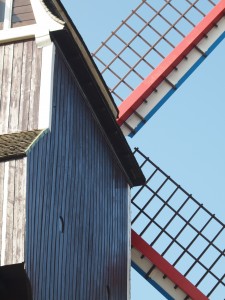
Walking along the Bruges ramparts from the Kruispoort, the first windmill one sees is the Bonne Chiere Mill, built in 1888 in Olsene and moved here in 1911.
Originally there were 25 windmills around the edge of Bruges (Belgium), but now only a handful remain. The ramparts that linked the city gates were used as a raised platform for the windmills and there are records of the 25 as early as 1562. While the four that remain are much newer than 1562, they still reflect that earlier time and ethic and take your breath away. For some reason I became obsessed with seeing windmills and walking to these windmills was the highlight of a highlight-filled European vacation.
Comparing Today’s Wind Turbines with Yesterday’s Windmills
I never thought much about windmills until I started driving across the country each year to visit family in Iowa and were continually encountering trucks transporting turbine blades along the highways of the Midwest. The wind turbine blades are some of the largest items I’ve ever seen. I find driving by the endless miles of wind turbine farms in northern Iowa, Minnesota and Wisconsin inspiring and calming. While many complain that they are ugly and destroy viewsheds and landscapes, to me, they are some of the simplest, most beautiful industrial structures I know. There is nothing extraneous. Less is definitely more here.
What I’ve learned is that if mechanical energy is used to produce electricity, the device may be called a wind generator or wind charger, or more commonly a turbine. If the mechanical energy is used to drive machinery, such as for grinding grain or pumping water, the device is called a windmill or wind pump. So, while the modern wind turbine is more likely wind for wind’s sake (or electricity), the historic windmill converts the wind into rotational energy by means of vanes called sails or blades for milling grain or other products for food production. While a bit more elaborate than today’s wind turbines, they are a purely designed functional item, which uses knowledge of the climate and region to provide for community.
Flour, Wind and Tourism

Windmills in Bruges. The Bonne Chiere Mill, (in the background) built in 1888 in Olsene and moved here in 1911 and the St. Janshuysmolen Mill (in the foreground) built in 1770.
One of the original gates to historic Bruges remains, the Kruispoort. The southern most windmill,nearest the Kruispoort, is Bonne Chiere Mill, built in 1888 in Olsene and moved here in 1911. The St. Janshuysmolen Mill was built by a group of bakers in 1770 and is the only one still in its original location. A small museum occupies this mill and is open during the summer, with grain milling demonstrations. The third mill from the city gate is the Nieuwe Papegaai Mill, a rebuilt oil mill placed here in 1970. The northernmost windmill, the Koeleweimolen, originally built around 1765, was rebuilt here in 1996 and is also open to the public for a small fee. Sadly we were a little early in the season and the windmills were not yet open for business. Their grandness and simplicity, even while not operating, captured my heart and I felt about them the same way I felt the first time I saw the Coliseum, the Pantheon and the Grand Canyon. It surprised me how thrilled I was. I took more photos of these windmills than I did of the Eiffel Tower or the Arc de Triomphe, although maybe not as many as Notre Dame, which is the subject of tomorrow’s blog!
Celebrating One Year

A detail of the St. Janshuysmolen Windmill which dates from 1770.
This week is the one year anniversary of my firm,
BAC/Architecture + Planning, PLLC. In honor of that, I am writing a blog a day for at least the five days of this week. I’m hoping that if I get into the habit of writing daily it might just stick! Thank you to all my readers, clients and colleagues for making this past year so wonderful and memorable. Today, April 18th, is the actual anniversary and I’d give my staff (me) the day off, except I’m really busy! And no complaints there!
This morning there was a piece on NPR discussing the importance of the “small business owner” to this country, and how identifying yourself as one represents hard work and the American spirit. Well I can certainly attest to the hard work part and I guess my spirit is “American” but looking at these photos of windmills in Bruges, I wish I were back in Belgium!!
And if you’d like to “subscribe” or follow this blog, True Green Cities, please sign up through the “Subscribe” button at the bottom left of this page. You’ll receive a daily recap when new blogs are posted.



